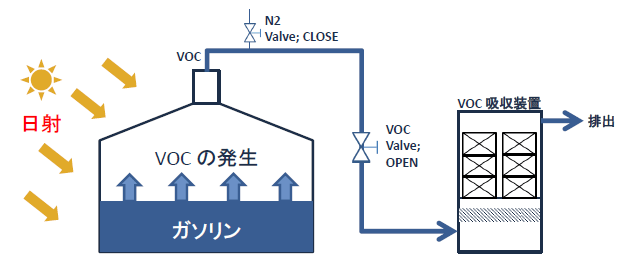Prediction of VOC Emissions from Storage Facilities Taking into Account the Atmospheric Temperature Increase due to Climate Change / Dynamic Analysis Simulator VOCSIM®
JGC HOLDINGS CORPORATION
| Publication date | May 09, 2018 (Posted on December 09, 2022) |
|---|---|
| Sector | Life of Citizenry and Urban Life |
Company Overview

Since its establishment in 1928, JGC CORPORATION has been engaged in the construction of a wide range of plants and facilities around the world, mainly in the oil and gas field including oil, natural gas, petrochemical, and LNG plants; extending to the energy infrastructure field including power plants and nonferrous metal plants; the industrial infrastructure field; the social infrastructure field including pharmaceutical plants, hospitals, and environmental facilities. The company is recognized as one of the world's leading engineering contractors.
Adaptation Initiatives
Increases in average temperature and daily changes in solar radiation and temperature (increases in maximum temperature) due to climate change will be factors that increase gas emissions that includes air pollutants (mainly VOCs, Volatile Organic Compounds), generated from storage facilities such as tanks storing petroleum or chemical products.
VOCSIM® (*1), a dynamic analysis simulator developed by JGC HOLDINGS CORPORATION, is capable of estimating VOC gas emissions based on predictions of future increases in air temperature and changes in solar radiation due to climate change. This technology makes it possible to design a VOC recovery facility that takes into account the increase in VOC emissions due to the expected rise of air temperature and fluctuation in solar radiation.

(*1) Outline of the dynamic analysis simulator VOCSIM®
In recent years, environmental regulations have been strengthened within and outside of Japan, requiring the reduction of volatile organic compounds (VOC) emission from storage facilities for products such as petroleum. One of the measures to reduce VOC emissions is the installation of VOC recovery facilities, and there has been an increasing demand for them, including demands from plant owners who are making personal efforts to take initiatives.
In order to design a VOC recovery facility, it is necessary to estimate how much gas is emitted from the storage facility, especially the amount of gas caused from the temperature rise by the heat coming in from the outside. We established a dynamic analysis method that takes into account the latitude, longitude, diurnal variation, and daylight hours of the storage facility location, as well as the rise in air temperature due to climate change, making it possible to estimate the amount of VOC gas emissions, which was considered to be difficult in the past.
This technology will allow the effects of future global warming to be reflected in the design of VOC recovery facilities, thus enabling appropriate adaptation of facilities when the climate changes.

The gas layer containing VOC is exhausted by expansion due to temperature rise.

- (Left) temperature distribution, (Right) velocity distribution *the red line at center indicates the liquid surface level

